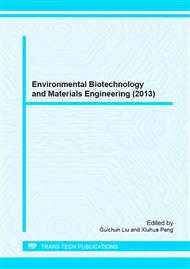[1]
Z. W. GAO, Z.Q. LIN, D. Wang, C.J. GAO, Seawater utilization and impact on environment in China, Marine Environmental Science 27 (2008)671-676.
Google Scholar
[2]
C. Sommariva, H. Hogg, K. Callister, Environmental impact of seawater desalination:Relations between improvement in efficiency and environmental impact, Desalination 167(2004) 439-444.
DOI: 10.1016/j.desal.2004.06.159
Google Scholar
[3]
X. H. MA, Z. LAN, S.F. WANG, L. LI, Impact of discharges in seawater desalination on marine environment and progress of zero liquid discharge, Chemical Industry and Engineering Progress 30 (2011)233-241.
Google Scholar
[4]
S. W. Ma, C. S. Kueh, G. W. Chiu, Environmental management of coastal cooling water discharges in Hong Kong, Wat. Sci. Tech. 38(1998) 267-274.
DOI: 10.2166/wst.1998.0815
Google Scholar
[5]
M.M. Elabbar, F.A. Elmabrouk, Environmental impact assessment for desalination plants in Libya. Case study: Benghazi North and Tobrouk desalination plants, Desalination 185(2005) 31-44.
DOI: 10.1016/j.desal.2005.02.074
Google Scholar
[6]
Z.Y. PANG, L. FENG, J.L. ZHOU, Z.T. LIU, Ecological risk assessment of substituted aromatic hydrocarbons in water of Yangtze river estuary , Environmental Chemistry 3(2011)430-434.
Google Scholar
[7]
C. J. Leeuwen, T. G. Vermerire, Risk assessment of chemicals an introduction, Boston: Kluwer Academic Publishers(1995).
Google Scholar
[8]
H. WANG, N.Y. YANG, R.Z. YU, Z. FANG, J.L. ZHOU , Research on Extrapolation Techniques of Eco-Environmental Risk Assessment for New Chemicals in China, Research of Environmental Sciences22 (2009)805-809.
Google Scholar
[9]
EU. Technical Guidance Document (TGD) on risk assessment of chemical substances following European regulations and directives, 2nd ed. Italy: EU, (2003).
Google Scholar
[10]
Quality Criteria for Water, U.S. EPA 440/5-86-001 (1986).
Google Scholar
[11]
Canadian Water Quality Guidelines for the Protection of Aquatic Life,Canadian Council of Ministers of the Environment 2007 Excerpt from Publication No. 1299; ISBN 1-896997-34-1.
Google Scholar
[12]
R. J. Bull, F. C. Kopfler, Health Effects of Disinfectants and Disinfection By- Products, AWWARF, Denver (1991).
Google Scholar


